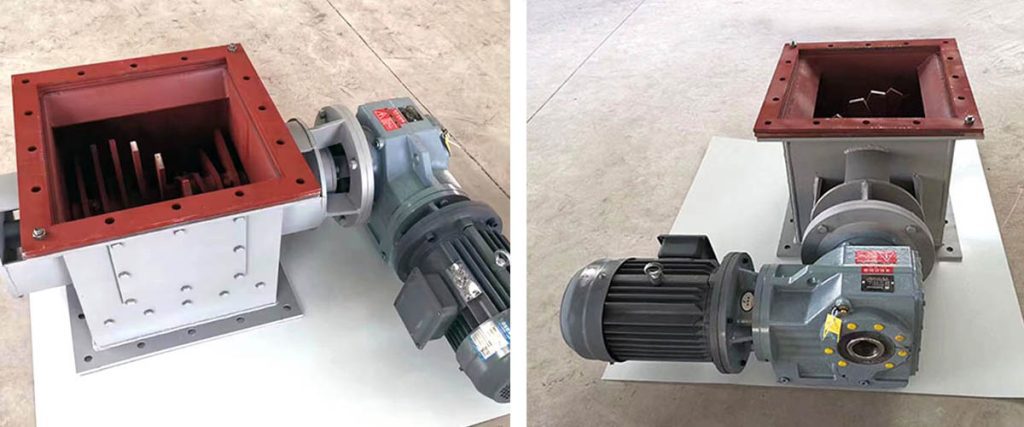In the intricate world of industrial bulk solids handling and powder processing, smooth material flow is not just desirable – it’s critical to efficiency, product quality, and profitability. Yet, a common adversary constantly threatens this flow: agglomerates, more familiarly known as lumps. These hardened masses disrupt silo discharge, choke conveyors, clog feeders, and compromise product uniformity. Enter the essential workhorse designed to combat this problem: the Lump Breaker. Often overlooked but indispensable, these machines are pivotal in countless industries. This article delves into the what, why, how, and where of lump breakers, ensuring you understand their vital role in optimizing your processes.
What is a Lump Breaker?
Simply put, a lump breaker (also frequently called a lump crusher, agglomerate breaker, or granulator in some contexts) is a mechanical device engineered to break down, reduce, or disintegrate agglomerated material into free-flowing particles. Their primary function is size reduction specifically targeting lumps, rather than fine grinding or pulverizing.
Lumps form for numerous reasons: * Moisture & Humidity: Absorbing ambient moisture, causing particles to clump together (caking). * Static Electricity: Particles cling together due to static charges. * Pressure: Material compacting under its own weight during prolonged storage in silos or bags. * Chemical Reaction: Minor reactions at interfaces forming bridges between particles. * Thermal Cycling: Heating and cooling cycles causing material to sinter or bond. * Poor Handling: Inefficient blending or transfer creating weak agglomerates.
Without intervention, these lumps can cause significant downstream issues, including: * Uneven feeding to packaging or processing equipment. * Product inconsistency affecting quality. * Increased downtime for manual lump removal or system jamming. * Underutilized storage capacity due to ratholing or bridging. * Wasted raw material (product trapped in lumps may be unusable). * Potential worker safety hazards from attempting to clear blockages.
How Lump Breakers Work: Principles and Mechanisms
Unlike crushers designed for hard rock or grinders for microns, lump breakers employ gentler, impact-based or crushing forces specifically calibrated to break apart loosely bound agglomerates without excessive generation of fines or dust.
- Material Intake: Agglomerated material is fed into the breaker, usually via gravity (from above) or conveyor.
- Encounter with Rotating Elements: The heart of the lump breaker typically consists of rotating elements interacting with stationary elements (or another set of rotating elements).
- Rotating Shafts/Paddles: One or more shafts equipped with fixed or replaceable paddles, blades, or spikes rotate at moderate speeds.
- Stator Elements: Stationary combs, breaker bars, or counter-knives strategically positioned in close proximity to the rotor.
- Impact & Shearing: As material enters the space between the rotor and stator (or between counter-rotating rotors), several forces act upon the lumps:
- Impact: Rotors smash lumps against the breaker bars or chamber walls.
- Shearing: The close clearance between rotating and stationary elements creates a scissor-like action that slices lumps apart.
- Compression: Material is briefly trapped and compressed between rotor elements and the breaker bars.
- Attrition: Particles within lumps rub against each other, further breaking bonds.
- Size Reduction: The combined action effectively crumbles lumps into smaller fragments.
- Material Discharge: Once reduced below the designed maximum lump size, the fragmented material passes through the gaps in the breaker bars or rotor cage and exits via gravity.
The key is achieving the necessary size reduction while minimizing mechanical action on the individual primary particles, thus preserving particle integrity and minimizing unwanted fine/dust generation.
Types of Lump Breakers: Finding the Right Fit
Lump breakers are designed for various capacities, material characteristics, and levels of agglomeration. Choosing the right type is critical:
Single Rotor Lump Breaker
- Description: Features one horizontal rotor shaft equipped with hardened paddles or spikes rotating within a housing lined with breaker bars.
- Mechanism: Lumps are broken by impact against the breaker bars, shearing between rotor paddles and bars, and collision with chamber walls.
- Advantages: Simple design, robust construction, relatively low maintenance, cost-effective. Excellent for moderate to dense lumps in many industries (food, chemicals, minerals).
- Limitations: Can generate slightly more fines compared to dual-shaft designs if not carefully configured for the material.
Dual Rotor Lump Breaker (or Twin Shaft)
- Description: Incorporates two parallel, counter-rotating horizontal shafts equipped with intermeshing teeth, paddles, or spikes. Breaker bars are often absent.
- Mechanism: Lumps are pulled into the nip point between the counter-rotating shafts, subjected to intense shearing and compression forces. The intermeshing action efficiently tears lumps apart.
- Advantages: Exceptionally effective for very tough, wet, sticky, or fibrous agglomerates. Generates fewer fines than single rotor designs. High capacity potential. Common in plastics recycling, wood chips, filter cakes, sludge.
- Limitations: More complex design than single rotor, potentially higher cost and maintenance (gear synchronization). Requires careful gap setting.
Gravity Lump Breaker
- Description: A more simple, often open-top design where material falls through a chamber containing rotating chains or flails.
- Mechanism: Agglomerates are broken primarily by impact with the swinging chains as the material descends under gravity.
- Advantages: Very gentle action, minimizes fines generation. Low power consumption. Simple installation (often mounted under silo outlets).
- Limitations: Less robust against very dense or tough lumps. Primarily impact-based. Lower capacity compared to paddle/rotor types. Best for friable materials and lighter agglomerates.
Mesh Screen Lump Breaker / Cage Mill
- Description: Features a rotor rotating inside a surrounding cylindrical mesh screen or cage. Material enters inside the rotor.
- Mechanism: Centrifugal force throws material against the internal cage walls. Particles small enough to pass through the mesh holes exit immediately. Larger lumps are struck repeatedly by the rotor arms until they break down sufficiently to exit.
- Advantages: Provides positive sizing control (output size defined by mesh opening). Efficient at breaking lumps to a specific top size. Common in fertilizer, minerals.
- Limitations: Screens can be prone to blinding with sticky or fibrous materials. Requires screen maintenance/replacement. Shear action is less prominent than in paddle breakers.
Key Industries and Applications
Lump breakers are ubiquitous wherever bulk solids are handled, stored, or processed:
- Food & Beverage: Breaking lumps in sugar, flour, starch, cocoa powder, milk powder, spices, dried fruits, instant drink mixes. Essential for consistent blending and packaging.
- Pharmaceuticals & Nutraceuticals: Ensuring free-flowing APIs, excipients (lactose, MCC), granulations, vitamin powders for accurate dosing and tablet/capsule production. Requires sanitary, FDA/GMP-compliant designs.
- Chemicals: Breaking up caked fertilizers (NPK, urea), pigments, dyes, detergents, resins, salts (road salt, industrial salts), plastic pellets/powders.
- Plastics & Recycling: Breaking large agglomerates or “fisheyes” in recycled plastic flakes (PET, HDPE), grinding plastic scrap chunks prior to extrusion. Dual rotor types excel here.
- Minerals & Building Materials: Disintegrating gypsum, bentonite clay, soda ash, potash, limestone fines, fly ash, cement kiln dust.
- Agriculture & Animal Feed: Breaking up caked grains, meals, supplements, premixes for consistent feed formulation and pelleting.
- Detergents & Personal Care: Preventing flow issues with powders like laundry detergent, soap powder, bath salts, talcum powder.
- Environmental & Waste: Processing filter cakes, dewatered sludge, agglomerated waste streams for disposal or recovery.
Maintenance: Ensuring Longevity and Reliability
Like all machinery, lump breakers need routine maintenance for optimal performance and lifespan:
- Regular Inspection: Periodically check rotor blades/paddles, breaker bars/cages for wear, damage, or buildup. Check shaft seals and bearings.
- Wear Parts Replacement: Rotor elements (blades, spikes, teeth), breaker bars, cage screens (if applicable) are consumables. Schedule replacement based on abrasiveness and operating hours. Keep spares.
- Lubrication: Follow manufacturer guidelines for bearing lubrication.
- Cleaning: Crucial, especially in sanitary applications (food, pharma) or with sticky materials. Many designs offer CIP/SIP options.
- Fastener Check: Periodically inspect bolts securing rotors, liners, covers.
- Operational Checks: Monitor for unusual noises, vibrations, or changes in output quality/flow, indicating potential issues.
Advantages: Why Invest in a Lump Breaker?
The benefits of integrating a properly selected lump breaker are substantial:
- Improved Material Flow: Eliminates blockages, ratholing, and bridging in silos, hoppers, and feeders.
- Enhanced Process Efficiency: Reduces downtime for unjamming equipment and manual lump removal. Ensures consistent feeding to downstream processes.
- Increased Production Uptime: Minimizes disruptions caused by flow problems.
- Consistent Product Quality: Produces uniform particle sizes crucial for blending, mixing, compaction (tabletting), coating, and packaging.
- Reduced Waste: Prevents product loss stuck in lumps or discarded due to inconsistency.
- Optimized Storage: Enables full silo/hopper utilization and reliable discharge.
- Cost Savings: Combines savings from reduced downtime, lower labor costs (manual lump removal), decreased waste, and improved process yields.
- Safer Working Environment: Reduces the need for manual intervention inside silos or around blocked equipment.

Key Takeaways & Conclusion
Lump breakers are not mere afterthoughts; they are strategically vital components for ensuring the smooth, efficient, and cost-effective flow of bulk solids in countless industries. By understanding the different types and their mechanisms (single rotor, dual rotor, gravity, cage mill), and by carefully evaluating your specific application needs (material properties, required capacity, output size, sanitary/hazardous environment requirements), you can select the optimal lump breaker to solve persistent agglomeration problems.
The investment in the right lump breaker translates directly to reliable operations, consistent product quality, minimized waste, reduced downtime, and significant cost savings. They unlock the full potential of bulk material handling systems, acting as the crucial gatekeeper that transforms problematic agglomerates back into free-flowing, process-ready material. Whether safeguarding sensitive pharmaceutical blends or breaking tough recycled plastic flakes, the lump breaker truly is an unsung hero of industrial efficiency.

